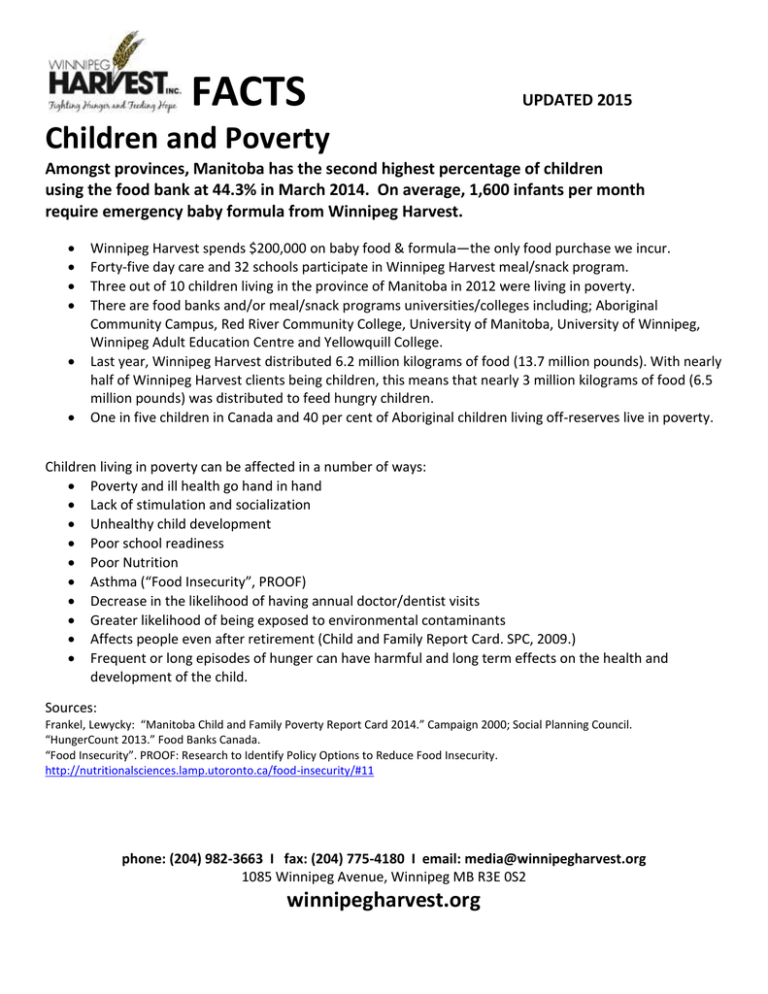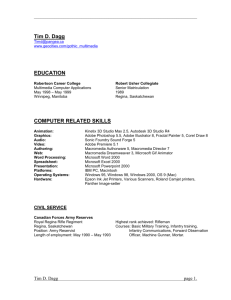Winnipeg_Harvest_FACTS_2015_v02
advertisement

FACTS UPDATED 2015 Children and Poverty Amongst provinces, Manitoba has the second highest percentage of children using the food bank at 44.3% in March 2014. On average, 1,600 infants per month require emergency baby formula from Winnipeg Harvest. Winnipeg Harvest spends $200,000 on baby food & formula—the only food purchase we incur. Forty-five day care and 32 schools participate in Winnipeg Harvest meal/snack program. Three out of 10 children living in the province of Manitoba in 2012 were living in poverty. There are food banks and/or meal/snack programs universities/colleges including; Aboriginal Community Campus, Red River Community College, University of Manitoba, University of Winnipeg, Winnipeg Adult Education Centre and Yellowquill College. Last year, Winnipeg Harvest distributed 6.2 million kilograms of food (13.7 million pounds). With nearly half of Winnipeg Harvest clients being children, this means that nearly 3 million kilograms of food (6.5 million pounds) was distributed to feed hungry children. One in five children in Canada and 40 per cent of Aboriginal children living off-reserves live in poverty. Children living in poverty can be affected in a number of ways: Poverty and ill health go hand in hand Lack of stimulation and socialization Unhealthy child development Poor school readiness Poor Nutrition Asthma (“Food Insecurity”, PROOF) Decrease in the likelihood of having annual doctor/dentist visits Greater likelihood of being exposed to environmental contaminants Affects people even after retirement (Child and Family Report Card. SPC, 2009.) Frequent or long episodes of hunger can have harmful and long term effects on the health and development of the child. Sources: Frankel, Lewycky: “Manitoba Child and Family Poverty Report Card 2014.” Campaign 2000; Social Planning Council. “HungerCount 2013.” Food Banks Canada. “Food Insecurity”. PROOF: Research to Identify Policy Options to Reduce Food Insecurity. http://nutritionalsciences.lamp.utoronto.ca/food-insecurity/#11 phone: (204) 982-3663 I fax: (204) 775-4180 I email: media@winnipegharvest.org 1085 Winnipeg Avenue, Winnipeg MB R3E 0S2 winnipegharvest.org FACTS UPDATED 2015 Homelessness in Winnipeg Over the course of 2014, the Winnipeg Poverty Reduction Council estimated that approximately 2,750 people experienced homelessness in Winnipeg. Of that figure, 30 per cent are women. It is estimated that approximately each night 350 individuals stay in one of Winnipeg’s homeless shelters every night. Approximately 9,625 individuals (3.5 times the homelessness figure) make up a ‘hidden homelessness’ population. “Hidden Homelessness” refers specifically to those who live temporarily with friends, neighbors, relatives or even strangers because they have no other option. They are considered “hidden” because they do not access homeless support services even though they are improperly or inadequately housed. The number of ‘hidden homeless’ across Canada ranges from 450,000 to 900,000. Each night there are approximately 700-1,000 people living in single room occupancy hotels in Winnipeg. (‘The Plan to End Homelessness in Winnipeg’. United Way, 2014, pg. 14) The number of people estimated to be living in a core housing need is 43,000 (2011) in Manitoba, that’s 10.3% of all Manitoba households. The rental vacancy rate in Winnipeg is 2%.(‘Winnipeg and Manitoba Housing Data, 2015’, pg. 3) Approximately 10% of Winnipeg’s homeless population are individual under the age of 25 and poverty and homelessness affects the lives of nearly one in three children in Manitoba. (‘The Plan to End Homelessness in Winnipeg’. United Way, 2014, pg. 16) Across Canada, it’s estimated that over 235,000 different Canadians will experience homelessness each year. On any given night, around 35,000 Canadians are homeless. (The State of Homelessness in Canada: 2014) Sources: Brandon, ‘Winnipeg and Manitoba Housing Data 2015’. Canadian Centre for Policy Alternatives. February 17, 2015. https://www.policyalternatives.ca/sites/default/files/uploads/publications/Manitoba%20Office/2015/02/Winnipeg%20and%20Man itoba%20Housing%20Data%202015%20January%2018.pdf. Gaetz, Gulliver, Richter (2014).The State of Homelessness in Canada: 2014.Toronto:The Homeless Hub Press. Retrieved from: http://www.homelesshub.ca/SOHC2014. The Plan to End Homelessness in Winnipeg. United Way, April 2014. http://unitedwaywinnipeg.ca/wpcontent/uploads/2014/04/wprc.plantoendhomelessness.april14.pdf phone: (204) 982-3663 I fax: (204) 775-4180 I email: media@winnipegharvest.org 1085 Winnipeg Avenue, Winnipeg MB R3E 0S2 winnipegharvest.org FACTS UPDATED 2015 Rural Communities It’s not just a Winnipeg thing. Rural communities and Winnipeg Harvest are partners in fighting hunger in Manitoba. Harvest shares food with approximately 47 agencies in rural Manitoba. These agencies share food with over 10,000 people per month on average—nearly 45 per cent of them are children. Winnipeg Harvest distributes food to several hubs throughout the province through the Manitoba Association of Food Banks, including Gimli in the Interlake region, Brandon in the Northwestern region, and Sagkeeng First Nation in the Eastern region. Harvest is also a distribution centre for 34 communities in Southern Manitoba. All of these communities support us in turn through donations of money, food, and time. When transportation is available (via ice roads or airplanes), Winnipeg Harvest also shares food with Manitoba’s northern communities. Rural communities donated in excess of 2 million pounds of food to Winnipeg Harvest last year, accounting for more than 30% of the food donated to Harvest last year. These donations come from dairy producers, vegetable and grain farmers, hog, cattle, and poultry producers, wholesalers, retailers, schools, faith communities and individuals. Of that 2 million pounds, Manitoba vegetable growers alone donate over 1 million pounds of produce to Winnipeg Harvest each year on average. Harvest’s Grow-A-Row program is becoming increasingly popular in rural communities. Dozens of communities now grow extra rows of vegetables (even entire gardens!) and donate them to Winnipeg Harvest. Due to a number of factors, the cost of food is notably higher in smaller communities, and even worse in central and northern regions. Even just 30 miles outside of Brandon, food is considerably more expensive, and even more so in isolated northern communities. Sources: Winnipeg Harvest Annual Report, 2014-2015 Hunger Count 2014, Food Banks Canada phone: (204) 982-3663 I fax: (204) 775-4180 I email: media@winnipegharvest.org 1085 Winnipeg Avenue, Winnipeg MB R3E 0S2 winnipegharvest.org FACTS UPDATED 2015 Women and Poverty “Empower women and you will see a decrease in poverty, illiteracy, disease and violence.” - Michaelle Jean, Governor General of Canada 2006 In Canada, 2.3 million women are living in poverty. In Manitoba, 92,000, or 15.5% of women, are living in poverty. Almost half (49.4%) of people in female-led single parent families live in poverty. 22.4% of children in Manitoba live in poor families (1/5); in Canada this is 14.3% (1/6) 26.1% of all unattached elderly women live in poverty in Manitoba. Faces of women in poverty: Aboriginal women (First Nations, Métis, Inuit) 36%, Visible minority women-35%, Disabled—26%, Single parent mothers—21% Single seniors—14% ***Note: Can belong to more than one group When children are poor, it’s usually because their mother is poor. 80% of all lone-parent families are headed by women. This adds up to over 1 million families, and they are among the poorest in the country. Single moms have a net worth of only about $17,000, while single dads have about $80,000 (Net worth is the total value of possessions such as a car, furniture, real estate, savings, stocks, RRSPs, etc.) 70% of part-time workers and 66% of minimum wage earners are female. Women who work full-time earn about 71 cents for every dollar earned by men. 7 out of 10 part-time workers and 60% of minimum wage earners are female People who rely on social assistance live in poverty. A woman raising one child on her own could receive as little as $14,829 per year in welfare benefits. That’s $1,235 per month. After paying rent, she would have very little left to buy food, clothing, bus tickets, school supplies, and other essentials. Canada’s lack of affordable childcare and the lack of workplace policies such as flex time and caregiver leave often forces women into career choices that severely limit their earning power. Canadian women with children earn 12 per cent less that women without children The income of the female student falls far below the 2012 ALL report ($22,607) even if she works at a minimum*wage job part*time during the school year and full*time during the summer ($14,878) Student loans also provide only about half the income needed ($11,900) Source: Tax filer data 2011, Statistics Canada-2011 (CANSIM-key socioeconomic database), 2012 Acceptable Living Level Report (ALL)Winnipeg Harvest and Canadian Women’s Foundation 2013 phone: (204) 982-3663 I fax: (204) 775-4180 I email: media@winnipegharvest.org 1085 Winnipeg Avenue, Winnipeg MB R3E 0S2 winnipegharvest.org FACTS UPDATED 2015 Poverty and Children’s Health Income and social status are the most important determinants of health in children. Statistics Poverty places children at a higher risk of death, disability, chronic illness and many other health problems throughout their lives Lack of money affects the quantity and quality of food needed to nurture a child adequately Research shows that poor children have “reduced motivation to learn, delayed cognitive development, lower achievement, less participation in extra-curricular activities, lower career aspirations, interrupted school attendance, lower university attendance, an increased risk of illiteracy, and higher drop-out rates.” Second only to smoking, poor nutrition in mothers is the greatest contributing factor to low birthweight babies Nutrition Studies show that regular nutrition improves a student’s grades, concentration, health and social behaviour Poor nutrition in childhood raises the risk of poor health in adulthood Children living in poverty are 2.5 times more likely to have a significant calorie deficiency than other children It costs over $27 a month to provide one child with 3 glasses (8 oz. each) of milk each day Babies born to mothers suffering poor nutrition have a medical cost of $13,870.10 in the first year of their lives, compared to $673.89 for healthy babies Low Birth Weight A low birth weight is the leading cause of infant death and illness in infancy and childhood Children surviving low birth weight are at a greater risk of lifelong disabilities, such as psychological, developmental, visual and hearing impairments A Canadian study found that the low birth weight rate is 43% higher in the poorest income bracket than in the richest bracket. Source: “Davos WEF 2011: Wealth inequality is the ‘most serious challenge for the world,” Philip Aldrick, The Telegraph, January 26, 2011. “Poverty and policy in Canada: Implications for health and quality of life”, by Dennis Raphael phone: (204) 982-3663 I fax: (204) 775-4180 I email: media@winnipegharvest.org 1085 Winnipeg Avenue, Winnipeg MB R3E 0S2 winnipegharvest.org






